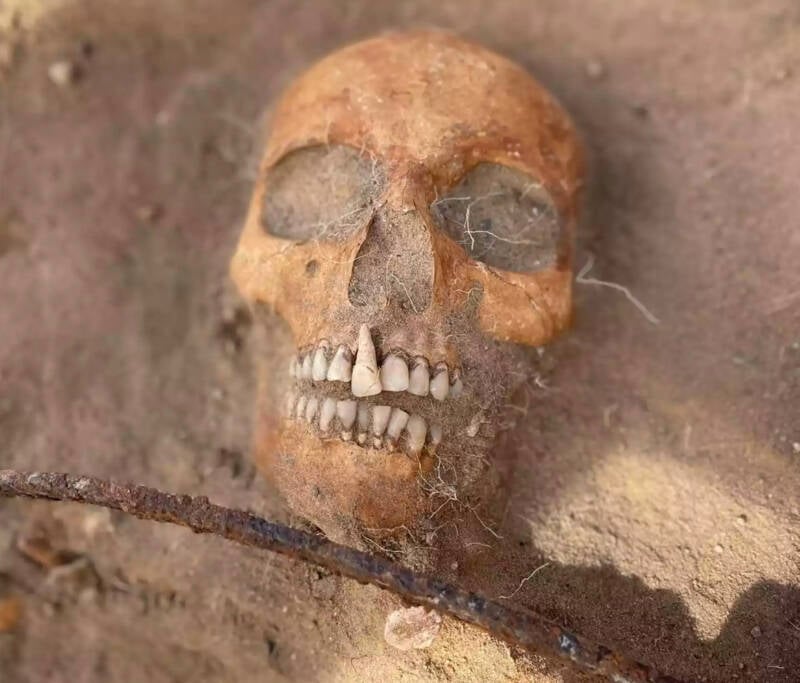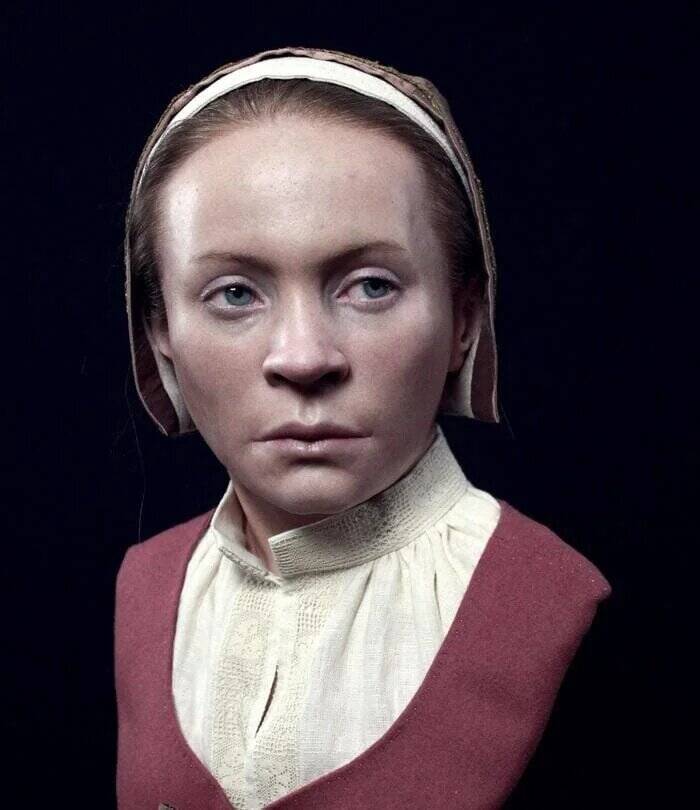In 2022, researchers in Poland unearthed a 17th-century "vampire," a young woman since dubbed Zosia, buried with a sickle across her neck and a padlock on her foot. Now, experts have both reconstructed her face and unveiled a possible reason for why she was thought of as a monster.

PBSA blade was placed just above the neck of the “Vampire of Pień” in order to prevent her from rising up out of the grave.
Throughout the 17th century, Europe was repeatedly ravaged by war. The Thirty Years’ War, for instance, raged across Central Europe and claimed some 8 million lives. Towns across the region were struggling with famine and disease, in turn giving rise to panic and fearful superstition.
Unfortunately, one young woman in Poland fell victim to this heightened tension. Her burial, discovered near the village of Pień in 2022, contained a sickle placed across her neck and a padlock on her foot — a telltale sign of a “vampire” burial.
These burials were meant to protect communities from the evil spirits of individuals who were deemed supernatural and likely to rise from the grave. The most common targets for these types of burials included foreigners, individuals with disabilities, and those who did not adhere to social norms.
Now, more than 400 years after her burial, this young woman dubbed “Zosia” has been given new life thanks to a team of researchers and anthropologists. For the first time, details about Zosia’s life, including what she looked like and why she may have been labeled a monster, have come to light.
17th-Century Woman Buried With Anti-Vampire Countermeasures Found In Poland

PBSThe burial of the 17th-century “vampire” woman, complete with a sickle near her neck and a padlock on her foot.
In 2022, Professor Dariusz Poliński and his team from the Archaeology Institute of Nicolaus Copernicus University (NCU) uncovered a curious burial in a 17th-century cemetery in the village of Pień, Poland.
The burial contained a young woman, likely between the ages of 17 and 21, buried in Grave No. 75 with an iron sickle near her neck and a padlock on the big toe of her left foot.
Immediately, the research team knew they had stumbled upon a “vampire” burial. These burials were common in Eastern and Central Europe in the 17th century and usually contained sharp objects or other countermeasures to stop the dead from rising up out of the grave.
According to Slavic folklore, vampires could return from the dead and wreak havoc on communities unless proper safety measures were put in place at their grave. Unfortunately for Zosia, her community believed her to be this sort of threatening creature and buried her accordingly to ensure that she wouldn’t rise from the dead.
While other Polish “vampire” burials containing such countermeasures have been found before, including a child “vampire” burial stuffed with rocks to hold the body down and another child burial right in Pień, this specific burial was the first ever discovered in Poland to contain a padlock and sickle.

Andrzej RomanskiPadlocks unearthed in “vampire” graves in Pień, Poland.
Historical records suggest that many individuals who received these vampire burials were often ones who went against societal standards. They may have been foreign, had unusual physical features, or broke social codes, like having children out of wedlock.
Interestingly, Zosia appears to have come from an elite family, as her burial contains traces of a pillow, fragments of silk threads, and precious metals. This adds a layer of mystery to her story and why she received a “vampire” burial. According to Professor Poliński in The Past:
“She was neither ritually murdered nor was she one of the convicted in the witchcraft trial. Those individuals were treated in a different way and, usually, they were thrown into provisional graves. It is possible that in her lifetime the woman experienced a tragedy and was harmed. On the other hand, her appearance or behavior might have provoked the contemporary residents to be afraid of her.”
Researchers Reconstruct The Face Of Zosia, The Vampire of Pień

“Evolution” Educational Association of TorunThe reconstructed face of Zosia, the “Vampire of Pień.”
Although the exact reason for Zosia’s “vampire” burial remains uncertain, researchers have now gained insights about both her appearance and her medical history.
Working alongside anthropologists, medical experts, and forensic specialists, the research team successfully analyzed Zosia’s features and created a 3D rendering of her face. The team also extracted DNA from Zosia and discovered that she may have had Scandinavian ancestry.
The recreation of her face began with creating a 3D-printed replica of her skull. Then, the team added layers of plasticine clay to emulate facial muscles until it revealed a realistic human face. Information about her gender, age, and ethnicity were also used to help the modeling process.
During this process, the research team discovered that the young woman suffered from a hemangioma, a tumor in the sternum. This likely would have caused Zosia discomfort and manifested in a visible chest deformity.
This ailment could also unlock the mystery behind why Zosia received a “vampire” burial, as her condition could have given her other side effects that likely would have been perceived negatively by her community, such as fainting spells, extreme headaches, and even mental health issues.
At the end of the project, the research team felt a strong sense of satisfaction that they had given Zosia her identity back. No longer was she an unknown individual whose only identifier was a monster’s burial. Instead, she had a name, and more importantly, a face.
“It’s really ironic, in a way,” Swedish archaeologist Oscar Nilsson told NBC News. “These people burying her, they did everything they could in order to prevent her from coming back from the dead… we have done everything we can in order to bring her back to life.”
After reading about this vampire burial, dive into nine terrifying stories of alleged real-life vampires. Then, read about the lore surrounding vampires and how it’s evolved over the centuries.





